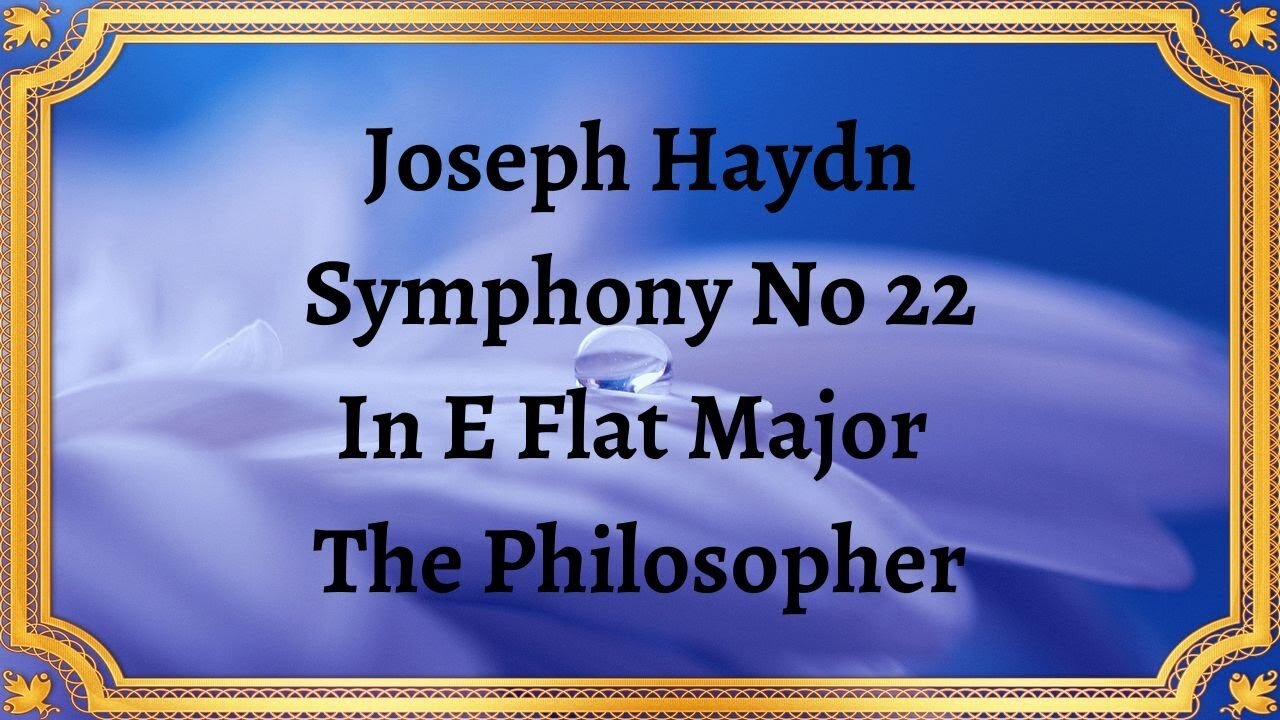Premium Only Content

Joseph Haydn Symphony No 22 In E Flat Major The Philosopher
#JosephHaydn #SymphonyNo22 #EFlatMajor #ThePhilosopher #classicalmusic #musicalcomposition #orchestra #composer #musictheory #violin #classicalperiod #symphony #musicappreciation #baroque #haydnsymphonies
Publication date 1951
THE LONDON BAROQUE ENSEMBLE Karl Nags Conductor
Joseph Haydn Symphony No. 22 in E Flat Major, also known as "The Philosopher," is a remarkable piece of music that showcases the genius of one of the most influential composers of the Classical period. This symphony, composed in the late 1760s, highlights Haydn's mastery of musical composition and his ability to create intricate and engaging works that captivate audiences to this day.
The symphony opens with a lively and energetic Allegro con brio movement. The orchestra introduces the main theme, which is characterized by its playful and joyful melodies. Haydn skillfully blends different musical elements, including dynamic shifts, intricate harmonies, and contrasting rhythms, to create a symphonic masterpiece that immediately captures the listener's attention. As the movement progresses, the music builds in intensity, showcasing Haydn's skill in orchestrating a multitude of instruments to create a harmonious and balanced sound.
Following the exuberant opening movement, Haydn surprises the listener with a contrasting slow movement, marked Adagio. In this section, the mood shifts to one of introspection and contemplation. The orchestra delicately weaves together layers of melodies, creating a serene and peaceful atmosphere. The rich harmonies and delicate orchestration demonstrate Haydn's ability to evoke emotion through his music. This movement serves as a beautiful interlude before the symphony continues with its vibrant and lively character.
The third movement, Menuet and Trio, brings a touch of elegance and grace to the symphony. The rhythmic and melodic interplay between the different sections of the orchestra creates a delightful dance-like atmosphere. Haydn's charming melodies and clever use of musical motifs make this movement a joyous and memorable part of the symphony.
The final movement, Presto, is a whirlwind of energy and excitement. Haydn showcases his compositional prowess by incorporating complex musical structures and rapid-fire passages. The orchestra engages in a lively dialogue, with each section taking turns to present their musical ideas. The movement builds to a thrilling climax, leaving the audience in awe of Haydn's ability to create such vibrant and exhilarating music.
"The Philosopher" Symphony is a testament to Joseph Haydn's skill as a composer and his ability to push the boundaries of musical composition during the Classical period. With its lively melodies, intricate harmonies, and dynamic contrasts, this symphony continues to captivate audiences and remains a timeless masterpiece in the world of classical music.
In conclusion, Joseph Haydn Symphony No. 22 in E Flat Major, "The Philosopher," is a brilliant example of Haydn's musical genius. Through its lively and energetic movements, contrasting moods, and intricate musical structure, this symphony showcases Haydn's mastery of composition and his ability to create music that resonates with listeners across generations. Whether you are a seasoned classical music enthusiast or a newcomer to the genre, experiencing "The Philosopher" Symphony is sure to be a captivating and enriching musical journey.
You have the opportunity to support the channel https://destream.net/live/RadSiarAl/donate
-
 11:57
11:57
inspirePlay
21 hours ago $9.45 earnedLongest Drive Wins! Elite Long Drivers Battle in Par 4 Elimination
84.5K12 -
 8:44
8:44
RTT: Guns & Gear
23 hours ago $5.57 earnedStreamlight TLR RM2 Laser - G | The Best PCC Light
63K5 -
 36:38
36:38
Athlete & Artist Show
1 month ago $3.39 earnedNCAA Hockey Was A Joke, TNT Hockey Panel Is The Best In Sports
47.8K2 -
 1:00:08
1:00:08
Trumpet Daily
1 day ago $6.46 earnedBanning Mystery of the Ages - Trumpet Daily | Jan. 17, 2025
32.7K36 -
 15:10
15:10
Chris From The 740
1 day ago $3.76 earnedEAA Girsan Disruptor X 500-Round Review: Is It Reliable?
48.1K4 -
 1:00:38
1:00:38
PMG
20 hours ago $6.49 earnedCarnivore & Dr. Shawn Baker - Health Starts With Food
61.8K8 -
 1:28:13
1:28:13
Kim Iversen
21 hours agoCancelled Chef Pete Evans Exposes The One Change That Could End Big Food and Pharma
123K105 -
 4:20:21
4:20:21
Nerdrotic
23 hours ago $89.78 earnedDaradevil Born Again, Comics Industry CRASH, Neu-Hollywood REBUILD | Friday Night Tights #337
272K70 -
 1:32:34
1:32:34
Glenn Greenwald
19 hours agoThe Future of Gaza With Abubaker Abed; Journalist Sam Husseini On His Physical Expulsion From Blinken’s Briefing & Biden’s Gaza Legacy | System Update #391
149K108 -
 1:34:48
1:34:48
Roseanne Barr
21 hours ago $31.45 earnedWe are so F*cking Punk Rock! with Drea de Matteo | The Roseanne Barr Podcast #83
114K98